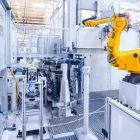A servo system, or servomechanism, is an automated control system designed to achieve precise motion control by continuously adjusting its output based on feedback. This feedback loop allows the system to maintain accuracy in controlling an object’s position, speed, and movement. As industries increasingly embrace automation, the importance of servo systems has surged, finding applications in various sectors such as robotics, CNC machining, and packaging.
Key applications of servo systems include:
- Robotics: Ensuring accurate movements in robotic arms for tasks ranging from assembly to surgery.
- CNC Machining: Providing precise control over cutting tools for manufacturing processes.
- Packaging: Enhancing speed and accuracy in packing products.
The benefits of employing servo systems are significant, including:
- Accuracy: Achieving high precision in motion control.
- Speed: Facilitating rapid adjustments and operations.
- Efficiency: Reducing energy consumption and operational costs.
Core Components of a Servo System
Servo Motor
Servo motors are integral to servo systems and come in various types:
- AC Servo Motors: Operate on alternating current (AC) and are known for their reliability and smooth performance. They excel in high-speed applications and heavy loads, making them ideal for industrial machinery.
- DC Servo Motors: Utilize direct current (DC) and are simpler to control. They respond quickly and are cost-effective, commonly used in low-power applications like toys and small robots.
- Linear Servo Motors: Convert rotational motion into linear movement, suitable for applications requiring straight-line actions.
Each type has its advantages and disadvantages. AC motors are robust but more complex, while DC motors are easier to manage but may have limitations in high-load scenarios.
Servo Drive (Amplifier)
The servo drive controls the motor by converting low-power command signals from the controller into high-power outputs. It plays a crucial role in the performance of the servo system. Different drive technologies include:
- Pulse Width Modulation (PWM): Controls motor speed by varying the width of electrical pulses.
- Vector Control: Provides precise control over torque and speed through advanced algorithms.
The drive receives commands from the controller and uses feedback from the motor to adjust performance dynamically.
Feedback Device (Encoder/Resolver)
Feedback devices like encoders or resolvers provide critical information about position and speed. Types include:
- Incremental Encoders: Measure changes in position relative to a starting point.
- Absolute Encoders: Provide a unique position value at all times, ensuring accuracy even after power loss.
Feedback accuracy and resolution are vital for maintaining system precision, as they directly influence how well the servo system can correct any discrepancies between desired and actual positions.
Controller (PLC/Motion Controller)
The controller issues motion commands based on input from users or automated processes. Different control strategies include:
- PID Control: A widely used algorithm that adjusts output based on proportional, integral, and derivative calculations.
- Motion Profiles: Predefined paths that dictate how a device should move over time.
Precise control algorithms ensure that commands translate effectively into accurate movements.
Principles of Servo System Operation
Servo systems operate on the principle of closed-loop control. In this setup, the interaction between components—motor, drive, feedback device, and controller—creates a feedback loop that ensures accuracy.
- Command Signal: The initial instruction sent from the controller to the motor.
- Feedback Signal: Information returned from the feedback device regarding the motor’s current position or speed.
- Error Signal: The difference between the command signal and feedback signal; this guides adjustments needed to minimize discrepancies.
This closed-loop mechanism allows servo systems to adaptively correct errors in real-time, enhancing overall performance and reliability across various applications.
Key Performance Parameters of Servo Systems
Accuracy
Accuracy in a servo system refers to how closely the actual position of the motor aligns with the desired position. High accuracy is vital in applications where precision is critical, such as CNC machining and robotic operations. An accurate servo system minimizes errors, leading to improved product quality and reduced waste.
Speed
Speed measures how quickly a servo motor can move to a specified position. Factors influencing speed include the type of motor used, load inertia, drive technology, and the implemented control algorithms. Faster speeds can enhance productivity but require careful torque and load dynamics management to maintain performance.
Torque
Torque is the rotational force generated by the servo motor. It is essential for determining how well a motor can handle various loads. Continuous torque is available for sustained operations, while peak torque is crucial for short bursts of high power, which is necessary in applications like robotic arms that require rapid movements.
Resolution
Resolution indicates the smallest movement increment that a servo system can detect or command. Higher resolution allows for finer control over movements, which is particularly important in high-precision applications such as medical devices and manufacturing processes. Improved resolution enhances overall system accuracy.
Bandwidth
Bandwidth represents the range of frequencies over which a servo system can operate effectively. A higher bandwidth allows for quicker responses to changes in control signals, improving overall system responsiveness. This characteristic is crucial in dynamic environments where rapid adjustments are necessary.
Servo System Selection Considerations
When choosing a servo system, consider the following factors:
- Application Requirements: Evaluate specific needs such as torque, speed, and accuracy based on the intended application.
- Motor Type Selection: Decide between AC, DC, or linear motors based on performance characteristics suited for your application.
- Drive Technology Considerations: Assess different drive technologies (e.g., PWM vs. vector control) for their efficiency and responsiveness.
- Feedback Device Selection: Choose appropriate feedback devices (incremental or absolute encoders) to ensure accurate position and speed information.
- Controller Capabilities: Ensure that the controller can effectively execute necessary algorithms for motion commands.
- Environmental Factors: Consider conditions like temperature fluctuations and vibrations that may impact system performance.
Pro Tip: Opt for servo systems with regenerative capabilities to minimize energy consumption and operational costs.
Servo System Applications Across Industries
Servo systems play a crucial role across various industries due to their precision and efficiency:
Manufacturing
Widely used in CNC machining for precise cutting operations, robotics for assembly tasks, packaging for automated processes, and material handling systems to enhance workflow efficiency.
Automation
Essential in automated assembly lines and pick-and-place systems where speed and accuracy are paramount, helping reduce human error and increase production rates.
Aerospace
Employed in flight control systems and robotics for tasks requiring high reliability and precision, ensuring safety and effectiveness in critical applications.
Automotive
Utilized in robotics within assembly lines for efficient production processes and engine control systems to enhance vehicle performance.
Other Industries
Find applications in medical devices for accurate surgical instruments, printing technology for high-quality outputs, textiles for precision manufacturing processes, and even renewable energy systems like solar tracking mechanisms.
Future Trends in Servo Systems
The landscape of servo systems is evolving rapidly, driven by technological advancements and the increasing demand for automation. Here are some key trends shaping the future of servo systems:
Advancements in Motor Technology
Future servo motors will feature higher efficiency and smaller sizes, allowing for more compact designs without sacrificing performance. Innovations in materials and manufacturing techniques, such as 3D printing, will enable the creation of lighter and more efficient components. These advancements will not only enhance performance but also reduce energy consumption, making servo systems more sustainable.
Improvements in Drive Technology
Drive technology is becoming more compact and intelligent. Modern servo drives will integrate advanced features that enhance control and responsiveness. For instance, ultra-fast current loop technology will provide near-instantaneous feedback, improving the bandwidth and speed of servo systems. This means that applications can achieve higher precision and faster operation.
Integration of Advanced Control Algorithms
The integration of artificial intelligence (AI) and machine learning into servo systems will revolutionize motion control. These technologies will enable self-tuning mechanisms that optimize performance in real-time, adapting to changing conditions without human intervention. Predictive maintenance algorithms will also forecast potential failures, reducing downtime and maintenance costs.
Increased Use of Communication Protocols
The adoption of advanced communication protocols like EtherCAT and PROFINET will facilitate seamless integration of servo systems into complex automation networks. This connectivity will allow for real-time data exchange between devices, enhancing synchronization and overall system efficiency.
Focus on Energy Efficiency
As industries strive for sustainability, energy efficiency will remain a top priority in the development of servo systems. Future designs will incorporate regenerative capabilities that capture and reuse energy generated during braking processes. Enhanced thermal management systems will further optimize energy use, ensuring that servo systems operate efficiently even in demanding environments.
Pro Tip: Implement predictive maintenance strategies to reduce downtime and extend the lifespan of your servo system.
FAQs
What is a servo system used for?
Servo systems are used for precise motion control in various applications such as robotics, CNC machining, and automated assembly lines.
How do I choose the right servo motor for my application?
Consider factors like torque requirements, speed capabilities, size constraints, and environmental conditions when selecting a servo motor.
What are the benefits of using AI in servo systems?
AI enhances performance through adaptive tuning, predictive maintenance, and improved energy efficiency.
What types of feedback devices are commonly used in servo systems?
Common feedback devices include incremental encoders, absolute encoders, and resolvers.
How can I improve the energy efficiency of my existing servo system?
Upgrading to modern drives with regenerative capabilities or implementing advanced control algorithms can significantly enhance energy efficiency.
About Fuji Electric Sales Philippines, Inc.
Fuji Electric Sales Philippines, Inc. is the local arm of Fuji Electric Co., Ltd., headquartered in Japan. The company focuses on the sales, promotion, and support of products that help boost energy efficiency, automation, and electrical infrastructure in the Philippines.
For more information or assistance with your servo system needs, please contact our expert team at Fuji Electric through:
Rickson Manalo
Assistant Sales Manager
0917-115 6102









